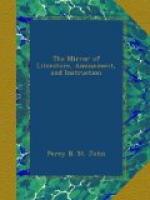THE LADY OF THE LAKE
Was written in 1809, and published in 1810, and was considered by the author as the best of his poetic compositions. He appears to have taken more than ordinary pains in its accuracy, especially in verifying the correctness of the local circumstances of the story. In his introduction to a late edition of the poem, he says—“I recollect, in particular, that to ascertain whether I was telling a probable tale, I went into Perthshire, to see whether King James could actually have ridden from the banks of Loch Venachar to Stirling Castle within the time supposed in the poem, and had the pleasure to satisfy myself that it was quite practicable.” The success of the poem “was certainly so extraordinary, as to induce him for the moment to conclude, that he had at last fixed a nail in the proverbially inconstant wheel of Fortune, whose stability in behalf of an individual, who had so boldly courted her favours for three successive times, had not as yet been shaken.”
ABBOTSFORD.—(See the Cuts.)
Since Sir Walter’s appointment to the sheriffdom of Selkirkshire, he had resided at Ashiesteel, on the banks of the Tweed, of which he was but the tenant. He was now desirous to purchase a small estate, and thereon build a house according to his own taste. He found a desirable site six or seven miles farther down the Tweed, in the neighbourhood of the public road between Melrose and Selkirk, and at nearly an equal distance from both of those towns: it was then occupied by a little farm onstead, which bore the name of Cartley Hole. The mansion is in what is termed the castellated Gothic style, embosomed in flourishing wood. It takes its name from a ford, formerly used by the monks of Melrose, across the Tweed, which now winds amongst a rich succession of woods and lawns. But we will borrow Mr. Allan Cunningham’s description of the estate, written during a visit to Abbotsford, in the summer of 1831:—“On the other side of the Tweed we had a fine view of Abbotsford, and all its policies and grounds. The whole is at once extensive and beautiful. The fast rising woods are already beginning to bury the house, which is none of the smallest; and the Tweed, which runs within gun-shot of the windows, can only be discerned here and there through the tapestry of boughs. A fine, open-work, Gothic screen half conceals and half shows the garden, as you stand in front of the house—(see the Engraving.) It was the offspring of necessity, for it became desirable to mask an unseemly old wall, on which are many goodly fruit-trees. What we most admired about the estate, was the naturally useful and elegant manner in which the great poet has laid out the plantations—first, with respect to the bounding or enclosing line; and secondly, with regard to the skilful distribution of the trees, both for the contrast of light and shade,




